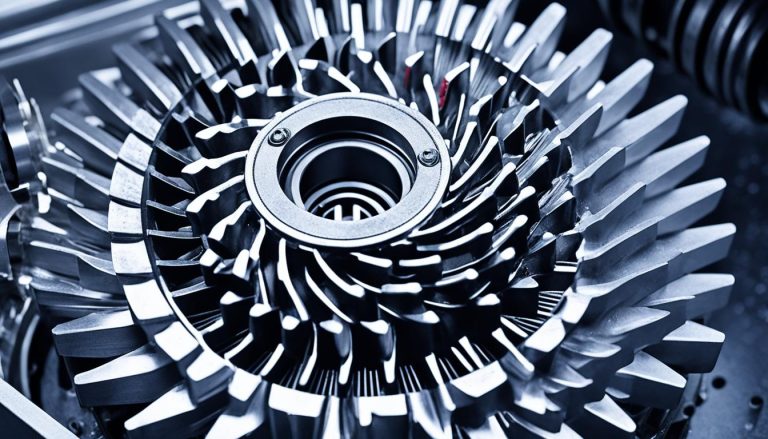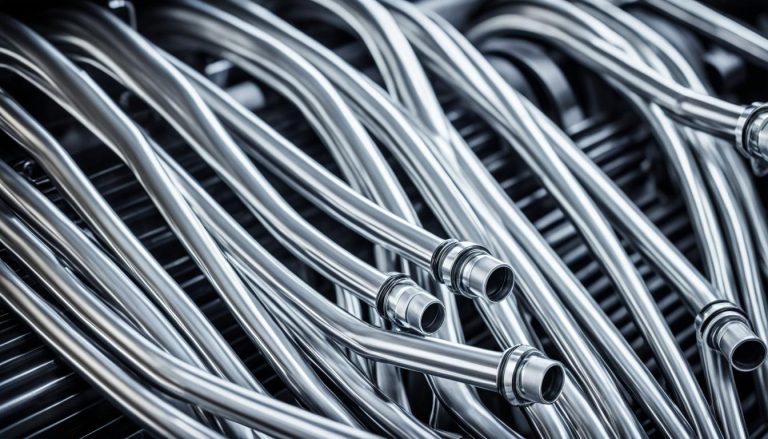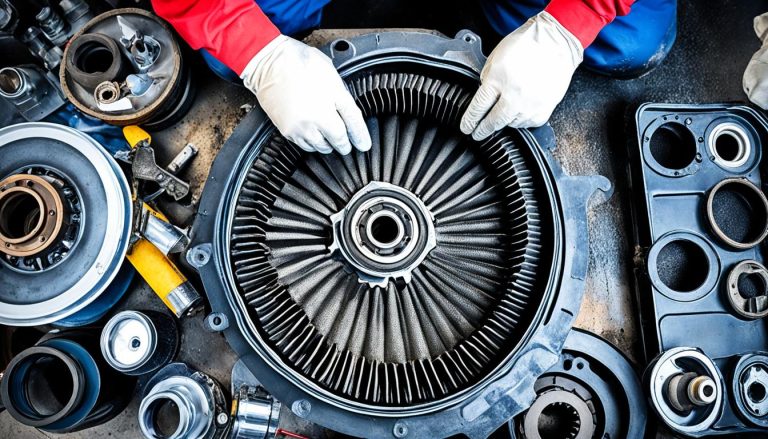Optimize Gears: Best Transmission Cooling Fluid
Maintaining an efficient and reliable transmission system is pivotal in the lifecycle of a vehicle. Elevated temperatures inside a transmission can compromise its integrity and longevity. However, introducing a high-quality transmission cooling fluid into the maintenance routine can play a crucial role in protecting against these heat-induced risks. Specially formulated fluids for automatic, dual-clutch, and manual transmissions each tackle unique demands, from shear stability to high temperature resistance, and are essential to ensure smooth gear operation and to extend your vehicle’s performance.
A regular transmission service including a thoughtful selection and application of the right automotive fluids can prevent the headaches of unexpected breakdowns and costly repairs. Knowing the importance of fluid maintenance can make all the difference between a vehicle that thrives on the road and one that fails prematurely.
Key Takeaways
- High-quality transmission cooling fluid is key for efficient vehicle operation.
- Choosing the right fluid is essential for protecting against high temperatures.
- Fluids are specifically designed for different types of transmissions.
- Regular transmission service and fluid maintenance are crucial for longevity.
- Appropriate fluid choice can enhance performance and prevent overheating.
The Critical Role of Transmission Cooling Fluid in Vehicle Performance
The lifeblood of any vehicle’s transmission is undoubtedly its transmission cooling fluid. This seemingly simple substance is packed with sophisticated chemistry designed to perform multiple critical functions. From lubrication to heat transfer, the transmission cooling fluid forms the core of an efficient cooling system, keeping transmission overheating at bay and ensuring that the transmission operates within an optimal temperature range.
Beyond keeping temperatures in check, the right type of transmission cooling fluid brings with it a host of multifunctional additives. These additives serve as foam suppressors to maintain consistent hydraulic pressure within the transmission, and as corrosion inhibitors to protect the transmission’s intricate metallic components from deteriorating prematurely.
Through the synergistic actions of its components, transmission cooling fluid reduces friction between moving parts, contributes to smoother gear shifts, and ultimately decreases the likelihood of transmission-related troubles. By doing so, the cooling fluid not only contributes greatly to the overall performance of a vehicle but also helps avoid transmission repairs which can be both inconvenient and financially burdensome for the vehicle owner.
In understanding the importance of these fluids, it is clear that drivers should duly prioritize maintaining their vehicle’s transmission cooling system. Regular checks and usage of high-quality fluids directly translate to more reliable vehicle performance and longevity, putting an emphasis on the pivotal role played by transmission cooling fluid in vehicle maintenance. By proactively ensuring the transmission does not succumb to overheating, these specialized fluids save car owners from the hassle and costs associated with transmission failures.
Types of Transmission Cooling Fluids and Their Distinct Advantages
When it comes to maintaining the health and efficiency of your vehicle’s transmission, the right type of transmission fluid is key. From automatic vehicles to high-performance racing cars, there’s a specific formulation designed to cater to the needs of each system, providing both cooling and lubricating properties that are essential for smooth operation. In this section, we delve into the major types of transmission fluids and their distinct benefits.
Automatic Transmission Fluid (ATF)
Designed for automatic transmission systems, ATF provides a multitude of benefits including heat dissipation, smooth power transfer, and adequate lubrication for the moving parts within the transmission. The versatility of ATF makes it a staple in the automotive industry, helping to extend the life of the vehicle’s transmission.
Dual Clutch Transmission Fluid (DCT Fluid)
The advancement in transmission technology has seen the rise of the dual clutch racing transmission fluid. Optimized for dual-clutch systems, this specialized fluid ensures rapid gear shifts, high thermal stability, and effective cooling to handle the high demands placed on DCT systems, particularly in performance and racing scenarios.
Synthetic Synchromesh Transmission Fluid (STF)
For those with manual transmissions featuring synchronized gearboxes, the synthetic synchromesh transmission fluid provides excellent protection against wear and tear. Formulated to improve shifting smoothness and reliability, STF is particularly beneficial under extreme conditions, protecting against gear grinding and enhancing the overall driving experience.
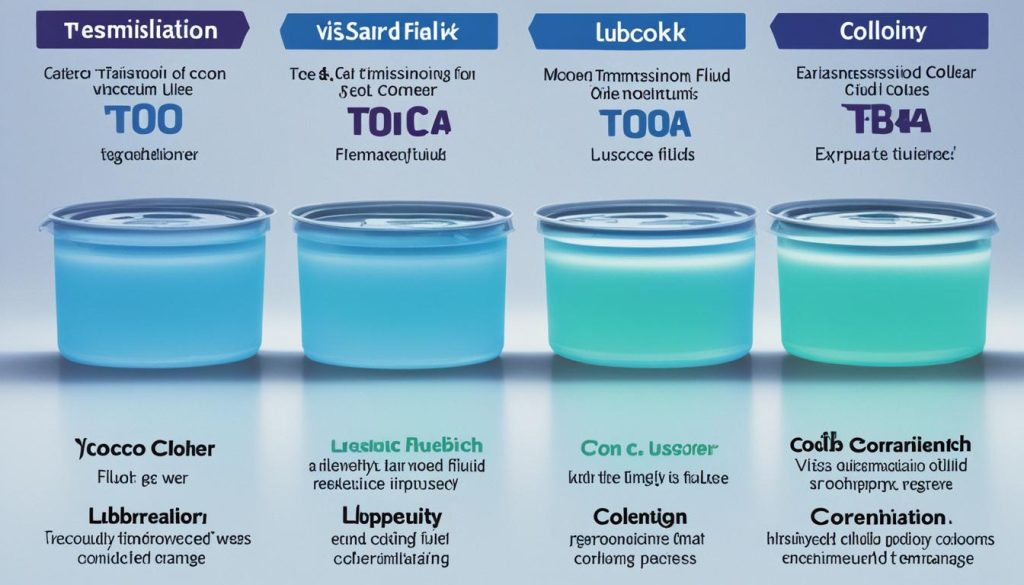
| Fluid Type | Main Benefits | Recommended Use |
|---|---|---|
| Automatic Transmission Fluid (ATF) | Cooling, lubrication, power transfer | Automatic transmissions |
| Dual Clutch Transmission Fluid (DCT Fluid) | Low temperature operation, smooth gear shifts | Dual-clutch transmissions (DCT), racing applications |
| Synthetic Synchromesh Transmission Fluid (STF) | Enhanced protection, smoother shifting | Manual transmissions with synchronized gears |
Choosing the right transmission fluid for your vehicle is not just a matter of performance—it’s an investment in your vehicle’s longevity. Whether you require ATF, DCT Fluid, or STF, each type offers unique advantages that contribute to a more efficient and reliable transmission system.
Transmission Cooling Fluid: The Hero in Preventing Overheating Issues
Effective management of transmission temperatures is paramount in maintaining a vehicle’s performance. Transmission cooling fluid emerges as a primary defense against the detrimental effects of excessive heat — a common culprit behind transmission overheating. It’s not only about preventing immediate issues; over time, high transmission temperatures can lead to thermal breakdown and reduced lubrication, which in turn can cause increased wear and even transmission failure.
Given the importance of maintaining optimal transmission health, it is essential to utilize a high-quality transmission cooler in tandem with the right automotive fluids. These components serve to dilute the intense heat generated during the vehicle’s operation, keeping the transmission functioning smoothly under a range of conditions.
- Reduces the risk of transmission overheating
- Prevents viscosity breakdown of the fluid
- Extends the service life of the transmission
In the pursuit of peak automotive maintenance, selecting the correct transmission cooling fluid is the key to averting the detrimental effects of high temperatures and shear stress. Below is a comparative snapshot illustrating how different transmission cooling fluids fare when faced with the demands of performance and temperature control.
| Brand | Type | High Temperature Resistivity | Anti-shear Qualities |
|---|---|---|---|
| Brand A | Synthetic | Excellent | High |
| Brand B | Mineral-based | Good | Moderate |
| Brand C | Blend | Very Good | Good |
When assessing the best transmission cooling fluid for your vehicle, consider not only the product’s specifications but also the unique demands of your driving habits and environment. Properly addressing these needs can significantly enhance transmission life and performance, ensuring your vehicle operates at its best even under pressure.
Choosing the right transmission cooling fluid is an investment in the longevity and reliability of your vehicle’s transmission system.

Assessing the Best Transmission Cooling Fluid for Racing Applications
When it comes to the high-octane world of racing, the selection of transmission cooling fluid becomes a critical factor in vehicle performance. These specialized fluids must offer high temperature protection and demonstrate shear stability to endure the extreme stress of racing conditions. Let’s explore how these fluids meet the demands of the track.
High Temperature Protection
Racing vehicles experience temperatures far beyond what is typical in standard driving scenarios. As a result, the transmission cooling fluid must be engineered to perform under these extreme conditions. Formulas that can withstand such rigorous heat help in maintaining the integrity of the transmission system, preventing thermal breakdown and ensuring responsiveness and efficiency of the vehicle’s powertrain.
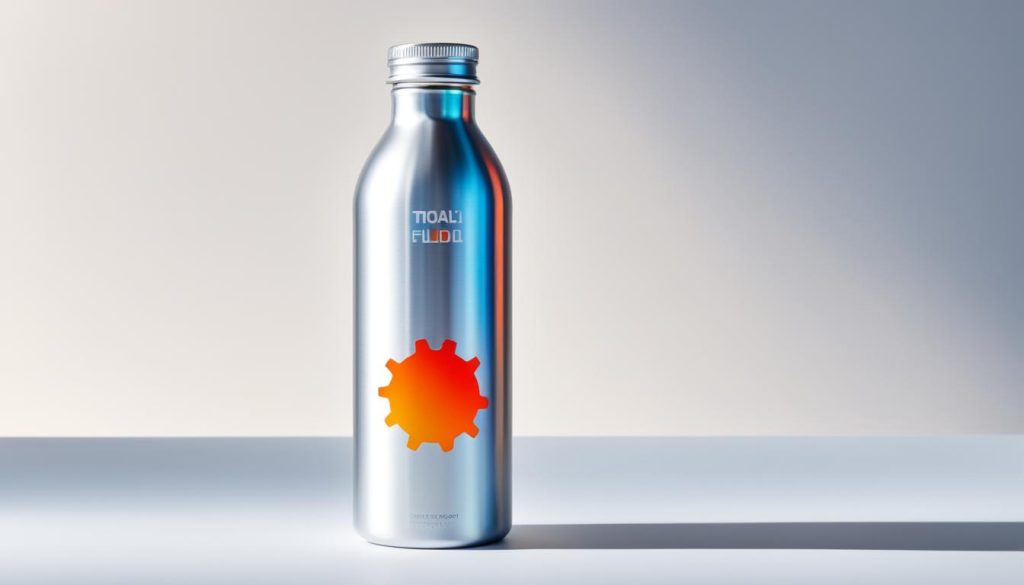
Shear Stability for Consistent Performance
Shear stability is another non-negotiable attribute of top racing transmission cooling fluids. It refers to the fluid’s ability to maintain its viscosity and structure under the intense shear forces it experiences during rapid gear changes and acceleration. A fluid with high shear stability will offer more reliable transmission performance, allowing drivers to confidently push their vehicles to the limit with each race.
Ultimately, the choice of transmission cooling fluid can make a significant difference in a racing vehicle’s drivability, power output, and even its likelihood of crossing the finish line without a hitch. Drivers, crews, and manufacturers all recognize the value of investing in fluids that deliver on both high temperature protection and shear stability to drive home a winning performance.
Comparative Analysis: Price Points for Top Transmission Cooling Fluid Brands
For those invested in the maintenance and performance of their vehicles, selecting the right transmission cooling fluid is a critical decision influenced not only by quality but also by cost. The market offers a range of transmission fluids at varying price points. In our comparative analysis, we explore the costs associated with some of the leading brands in the industry to empower consumers with informed choices without compromising the integrity of their automotive systems.
The table below encapsulates a curated selection of top transmission fluid brands, rated for their effectiveness and value. The price spectrum for these fluids is broad, with options suitable for both budget-conscious buyers and those who prioritize premium formulations for their vehicles. Carefully examine the features alongside the price tags to determine which transmission fluid offers the best deal for your particular automotive needs.
| Brand | Type | Volume | Price | Special Features |
|---|---|---|---|---|
| Valvoline MaxLife | Multi-Vehicle ATF | 1 Quart | $5.99 | Enhanced anti-wear protection |
| Castrol Transmax | Full Synthetic ATF | 1 Quart | $6.99 | Exceptional thermal protection |
| ACDelco Dexron VI | Automatic ATF | 1 Quart | $7.49 | Improved fuel efficiency |
| AMSOIL Signature Series | Synthetic ATF | 1 Gallon | $22.97 | Extended drain intervals |
| Red Line D4 ATF | Synthetic ATF | 1 Quart | $11.95 | High-performance formula |
Understanding the equilibrium between cost and quality is imperative for maintaining your vehicle’s transmission for the long haul. Remarkably, higher-priced transmission cooling fluids can offer advanced protective benefits, leading to less frequent fluid changes and potentially saving money over time. Conversely, more affordable options can also adequately meet the needs of daily drivers. Deciding on the best transmission fluid for your use is a personalized process that balances these various factors to ensure optimum vehicle health and performance for years to come.
Improving the Longevity of Your Transmission with Proper Fluid Maintenance
Meticulous upkeep of your vehicle’s lifeblood – the transmission fluid – is instrumental in enhancing the longevity and performance of your transmission system. Just as regular health check-ups are vital for well-being, timely fluid maintenance is essential for your vehicle’s transmission health.
Regular Checks and Top-Offs
Adhering to a routine schedule for inspecting and replenishing transmission fluid is as crucial as the fluids themselves. Regular checks help catch leaks or declines in fluid levels before they escalate into larger issues. Topping off the fluid ensures that your vehicle’s transmission components remain well-lubricated and function smoothly.
Understanding When to Replace Your Fluid
Knowing when to replace your transmission fluid plays a pivotal role in maintaining the health of your transmission. Like any fluid in your vehicle, transmission fluid degrades over time – affected by variables such as driving habits and temperature changes. This degradation impacts its ability to properly lubricate and can expedite wear on the transmission.
| Transmission Fluid Check | Recommended Action | Benefits |
|---|---|---|
| Low Fluid Level | Top-off with the correct fluid type | Prevents friction and overheating |
| Foul Smelling or Discolored Fluid | Complete fluid change | Removes contaminants and restores protective properties |
| Fluid with Particulate Matter | Inspect for potential transmission damage and replace fluid | Ensures the integrity of transmission parts |
Evaluating the Impact of Transmission Cooling Systems on Repair Frequency
The integrity of a vehicle’s transmission cooling system is integral to its longevity and performance. High-grade transmission cooling systems greatly reduce the likelihood and frequency of transmission repairs, contributing to a vehicle’s overall reliability. This connection is particularly evident when analyzing the role of the cooling system in regulating operating temperatures and mitigating the risks inherent in extreme driving conditions.
Reducing the Need for Transmission Repairs
The use of advanced transmission cooling systems offers remarkable benefits, primarily the reduction of stress on transmission components. This is achieved by maintaining optimal fluid temperatures, which, in turn, minimizes the wear and tear on the transmission parts. Consequently, this leads to a decrement in the need for frequent transmission repairs, an aspect critical for both personal and commercial vehicle operators.
How Cooling Fluid Quality Affects Transmission Service Intervals
Quality cooling fluids are instrumental in defining transmission service intervals. The formulations of these fluids are designed to tolerate harsh conditions without breaking down, thereby extending the periods between necessary services. Not only does this mean less downtime for maintenance, but it also signals cost savings in terms of transmission service expenses over the vehicle’s lifetime. The correlation between high-quality transmission cooling fluids and expanded service intervals is clear, delineating a direct impact on the vehicle’s maintenance schedule and long-term care.
Transmission Cooling Fluid and Its Symbiotic Relationship with Automotive Cooling Systems
The integral role of transmission cooling fluid within automotive cooling systems cannot be overstated. It is the lifeblood of transmission health—keenly managing the intricate balance between heat and operational efficiency. As vehicles undertake the rigors of daily commutes and long road trips, the stabilization of transmission temperature is vital for preventing thermal degradation and ensuring smooth vehicular performance.
Modern automotive technology has refined the compositions of transmission fluids to extend beyond their primary role of lubrication. These fluids are engineered to work harmoniously with the cooling systems, mitigating the impact of high temperatures on transmission components. It is an interconnected dance where each component relies on the efficacy of the other—a true symbiotic relationship.
- Preserving Engine Efficiency: By reducing the tendency for engine knock, also known as pre-detonation, transmission fluids underpin the peak performance of automotive engines.
- Wear Protection: The anti-wear additives in quality transmission fluids shield vital transmission parts, extending their service life significantly.
- Temperature Regulation: High-quality cooling fluids possess excellent thermal properties, directly contributing to the stability of the entire cooling system.
The synergy between transmission cooling fluid and automotive cooling systems extends beyond just functional interactions; it’s about maintaining the life cycle of the vehicle. Drivers can experience a more reliable, longer lasting, and overall more economical driving experience when these components work together flawlessly. The careful selection and maintenance of these fluids are thus paramount for any discerning motorist looking to optimize their vehicle’s lifespan.
Step-by-Step Guide: How to Select and Apply the Best Transmission Cooling Fluid
Selecting the right transmission cooling fluid is essential for any diligent vehicle owner. This critical component of fluid maintenance can dictate the overall performance and lifespan of your car’s transmission. The complexity of modern transmissions requires an analytical approach to determine the suitable fluid type. One must consider the vehicle’s specific conditions and manufacturer recommendations to ensure compatibility and optimal functionality. Whether it’s for routine transmission service or a full system overhaul, understanding the properties and applications of transmission cooling fluids is key.
Analyzing Vehicle Specifications and Performance Requirements
Before any transmission service, analyzing your vehicle’s specifications is a foundational step. Each vehicle has its unique set of requirements when it comes to transmission cooling fluids, and not all fluids are universally applicable. A high-performance sports car, for example, will have different cooling needs compared to a utility truck. Factors such as operating temperatures, transmission design, and intended use (like towing or racing) play a significant role in the selection process. By adhering to the recommended specifications, you not only maintain the health of your transmission but also prevent potential performance issues down the line.
Tips for Flushing and Replacing Fluid
Part and parcel of fluid maintenance is the process of flushing and replacing the old transmission cooling fluid. This task, while not overly complex, requires attention to detail. Ensuring you have the correct type and amount of fluid is paramount, as is following a methodical process to replace it. Draining the old fluid, cleaning the components, and carefully refilling the system will guarantee that your vehicle maintains its vigor for the road. Regular maintenance and timely servicing are the cornerstones of transmission longevity, and with these tips, your vehicle is set to deliver smooth, reliable performance every time you hit the road.
FAQ
What are the benefits of using transmission cooling fluid?
Transmission cooling fluid is essential for maintaining efficient transmission operation, providing protection against high temperatures, enhancing gear performance, and contributing to the transmission’s longevity and reliability.
Why is it important to prevent transmission overheating?
Preventing transmission overheating is crucial as it ensures smooth operation, prevents premature wear and costly repairs, and maintains the overall health of your cooling system and vehicle performance.
What types of transmission cooling fluids are available?
There are various types of transmission cooling fluids available for different transmission systems, including Automatic Transmission Fluid (ATF) for automatic transmissions, Dual Clutch Transmission Fluid (DCT Fluid) for dual-clutch systems, and Synthetic Synchromesh Transmission Fluid (STF) for manual transmissions with synchronized gears.
How do transmission cooling fluids prevent overheating issues?
High-quality transmission cooling fluids are formulated to withstand high temperatures, offer high shear stability, and contain additives that lubricate and protect the transmission components, all of which prevent overheating.
What should I consider when selecting transmission cooling fluid for racing applications?
When selecting transmission cooling fluid for racing applications, it’s essential to consider the fluid’s high temperature protection and shear stability to ensure consistent performance under extreme conditions.
How does the price of transmission cooling fluid affect its quality?
While price can be a consideration, the quality of transmission cooling fluid depends more on the formulation and compatibility with your vehicle’s requirements. It’s possible to find high-quality fluids within a reasonable price range that offer the protection and performance necessary.
How can I improve the longevity of my transmission?
Improving the longevity of your transmission can be achieved by regularly checking and topping off the transmission fluid, understanding the right time to replace your fluid, and ensuring that you use a high-quality fluid suitable for your vehicle.
How does transmission cooling fluid quality impact the frequency of transmission repairs?
Higher quality transmission cooling fluids often include better protective additives, which can reduce the frequency of needed repairs by preventing excessive wear and damage under various driving conditions.
Can transmission cooling fluid affect other parts of the automotive cooling system?
Yes, transmission cooling fluid plays an integral role in the overall automotive cooling system. Properly functioning transmission fluid helps maintain optimal temperatures for both the engine and transmission, enhancing the vehicle’s cooling efficiency.
How do I choose the best transmission cooling fluid for my vehicle?
To choose the best transmission cooling fluid, analyze your vehicle’s specifications and performance requirements. Consider factors such as the type of transmission, the operating environment, and whether the vehicle is used for daily driving, towing, or racing. Additionally, seek out fluids that meet or exceed the manufacturer’s recommendations.
What are some tips for flushing and replacing transmission fluid?
When flushing and replacing transmission fluid, use the correct type of fluid, follow the manufacturer’s recommended service intervals, and ensure that the replacement process includes properly draining old fluid, cleaning any accessible components, and refilling with the appropriate amount of new fluid. It’s also beneficial to check for any leaks after the service is completed.


